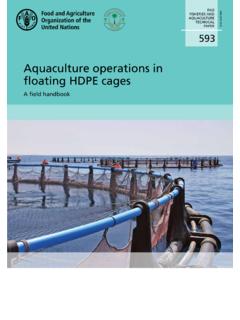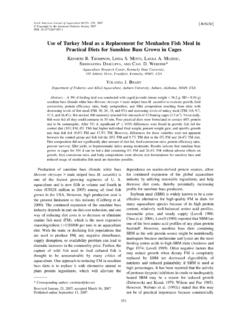Transcription of The Laboratory Mouse (Handbook of Experimental …
1 GeneralMice are the most widely used animals for a range ofexperiments including medical, chemical, pharmaco-logical, toxicological, biological, and genetic. Theadministration of test substances, such as chemical ele-ments, compounds, drugs, antibodies, cells or otheragents, to mice is one of the major methods for evalu-ating their biological route of administration is largely dependent onthe property of the test substance and the objective ofthe experiment. All administration should be performedwith knowledge of the chemical and physical characteris-tics of the substance. All routes have both demerit andmerit, such as the absorption, bioavailability and metab-olism of the substance. Consideration should be paid tothe pH, viscosity, concentration, sterility, pyrogenicity,toxicity as well as the existence of hazardous knowledge of available methods and techniques ofadministration as well as knowledge of the depositionand fate of the administered substance will help the scien-tist/investigator to select the most appropriate route forher/his purpose.
2 This route must be selected before thestart of any experiment (Nebendahl, 2000).Proper restraint is the most important techniquewhen mice were treated as this decreases stress andincreases successful treatment. Personnel using experi-mental animals should be well trained in handling andrestraint, should obtain authentication for responsibleuse of Experimental animals and attain a scientificallyhigh standard (ETS 123, 1986; Nebendahl, 2000).Further experience will lead to repeatable and reliableresults (see Chapter 31 on Handling and Restraint).During administration mice should be protectedfrom pain, suffering, distress or lasting harm or at leastpain and distress shall be kept to a minimum (ETS123, 1986). Some injections (such as footpad injec-tion) are strongly discouraged and if required must bejustified on a case by case basis (CCAC, 2002).
3 Principles ofadministrationHandling and restraintGood handling and restraint is the most importanttechnique for correct administration. Proper restrain-ing leads to successful administration and varies withthe routes of administration. Disposable gloves must beworn as manual restraint is frequently used for OFADMINISTRATION32 CHAPTERR outes of AdministrationShinya ShimizuNational Institute of Animal Health, Tsukuba, JapanThe Laboratory MouseCopyright 2004 ElsevierISBN 0-1233-6425-6 All rights of production in any form reservedThere are two styles of manual restraint, one uses bothhands and the other is single handed. (Chapter 31 onHandling and Restraint is helpful; Donovan andBrown, 1991; Suckow et al., 2000).Double handed manual restraintThe Mouse is lifted by the base of the tail and placed onthe cage lid or other solid surface with one hand and thenits tail is pulled gently back (Figure ).
4 It is quicklyand firmly picked up by the scruff of the neck behind theears with the thumb and index finger of the other hand(Figure ). The tail is transferred from the first handto between the palm and little or ring finger of the otherhand, then fixed (Figure ). The Mouse is restrained(Figure ).Single handed restraintThe tail is picked up using thumb and fore finger of thechosen hand (Figure ), then the Mouse is placedon the cage lid or other solid surface (Figure ).The tail is immediately grasped by the palm and middlefinger, ring finger and/or little finger, and the thumband forefinger released (Figure ). The fold of skinfrom the scruff of neck down the back is immediatelygripped using the thumb and forefinger (Figure e). The Mouse is then restrained (Figure ).
5 To prevent kicking by the hind legs, the tail isfixed using the palm and forefinger and then the lefthind leg is held firmly between the ring and little fin-ger (where the Mouse is restrained by the left hand)(Figure ).528 PROCEDURESROUTES OFADMINISTRATION(a)(c)(d)(b)Figure restraint of a Mouse using both hands. (a) The Mouse is placed on the cage lid with the preferredhand. The tail is pulled gently back by the hand. (b) The Mouse is quickly and firmly picked up by the scruff of the neckbehind the ears with thumb and index finger of other hand. (c) The tail is transferred from the preferred hand to betweenpalm and little or ring finger of the other hand, then held firmly. (d) The Mouse is restrained.(CCAC, 2002). In some cases a local anesthetic may beapplied first to prevent , solubility andsafety of solutionsTest substances, solutions and equipment should beprepared aseptically and free from pyrogens, especiallyfor parenteral injections.
6 Solutions can be sterilised byfiltration ( m). Living organisms or cells must befree from contaminants when administered. The toxic-ity of the substance, the volume and the way of admin-istration should be considered to prevent tissue damageand to give precise following solvents or vehicles have been foundsuitable in most instances and do not greatly affectdrug action because of their own inherent properties:water, water with sodium chloride, water withup to 50% polyethylene glycol, water with not over10% Tween 80, water with up to methylcellu-lose or carboxymethylcellulose, corn oil; vegetable oil;529 PROCEDURESROUTES OFADMINISTRATION(a)(b)(c)(d)(e)(f )Figure restraint of the Mouse . (a) The tail is picked up using thumb and forefinger of the preferredhand.
7 (b) The Mouse is placed on the cage lid or other solid surface pulling gently back by the hand. (c) The tail isimmediately grasped by the palm and middle finger, ring finger and/or little finger and then, the tail held between thumband forefinger is released. (d) and (e) The fold of skin from the scruff of the neck down the back is immediately grippedusing the thumb and forefinger. (f ) The Mouse is of administrationAmong several possibilities for the administration ofsubstances to mice, the most common routes aresubcutaneous, intraperitoneal or intravenous intramuscular administration is not recommended,as the muscle of the Mouse is too small. Some sites, suchas footpad injection of Freund s complete adjuvant,intrasplenic injection and intra lymph node injectionare unacceptable nowadays (CCAC, 2002), and shouldbe restricted to cases where it is absolutely of the siteThe area for administration is clipped (Figure ) orcleaned with warm water if necessary before cleaningthe skin with alcohol- or disinfectant-moistened aseptic skin is necessary; the fur must be clippedfollowed by a three-stage surgical preparation: surgicalsoap, alcoholic rinse and surgical preparation skin is dried immediately before administrationpeanut oil (oral and intramuscular route only).
8 A lowpercentage of the lower alcohols, glycols, and acetonecan also be used, provided the volume administered iskept small (Woodard, 1965). Phosphate buffered saline(PBS) or various culture media are also suitable vehicles(Nebendahl, 2000). Lipid-soluble substances can onlybe dissolved in oil but this delays absorption. Oil solu-ble drugs have been successfully given intravenously in15% oil water emulsions using lecithin as an emulsi-fier (Woodard, 1965).Unless experience has indicated otherwise, solutionsor suspensions should be prepared as near to the timeof use as possible because some substances will deterio-rate in solution within a few hours (Woodard, 1965).When administering drugs, the solvent should ideallybe the same as the one in which the drug is normallyformulated (Nebendahl, 2000).
9 Although distilled water can be used under certainconditions, saline is preferable because water ad injec-tioneminjected subcutaneously causes pain and intra-venous injection produces hemolysis. Oil and viscousfluids cannot be injected intravenously (Nebendahl,2000). If suspended material is to be used for intra-venous injection, the particles should be removed byfiltration to prevent embolism (Woodard, 1965).The temperature of fluids must be raised at least toroom temperature or better still up to body tempera-ture before use, because the injection of cold fluids ispainful (Baumans et al., 1993).Concentration of substancesThe concentration can vary over a fairly wide rangewithout greatly influencing the end result of the experi-ment. Lower concentrations are clearly desirable(Waynforth and Flecknell, 1992).
10 Factors limiting theuse of aqueous solutions for parenteral administrationare probably related to their osmotic pressure. Lowconcentrations can be corrected by the addition ofsodium chloride but ought not to be so high as tomaterially exceed the osmotic pressure of Msodium chloride (Woodard, 1965). Highly concen-trated solutions can be administered intravenouslyprovided the rate of injection is kept slow and precau-tions are taken to avoid getting the solution outsidethe OFADMINISTRATIONF igure restraint of a Mouse to prevent kicksby hind leg. The tail is held using the palm and forefingerand then the left hind leg is fixed between the ring andlittle finger (when the Mouse is restrained by the left hand).Figure of hair on the back. Hair on the back is clipped by a cordless electric of the injected solutionFor most routes of administration, providing the solu-tions are not highly buffered, a pH range of issatisfactory.











